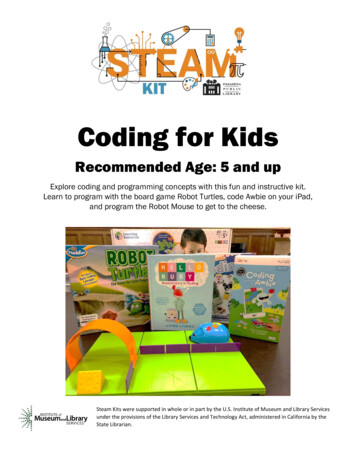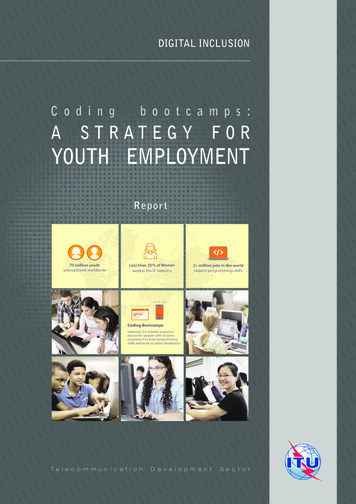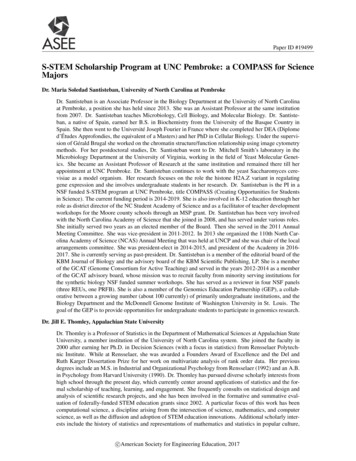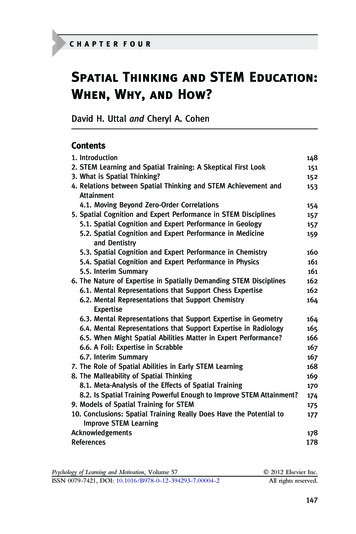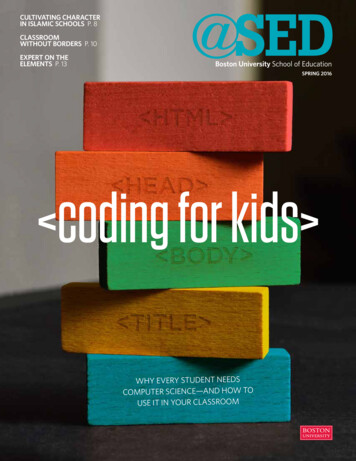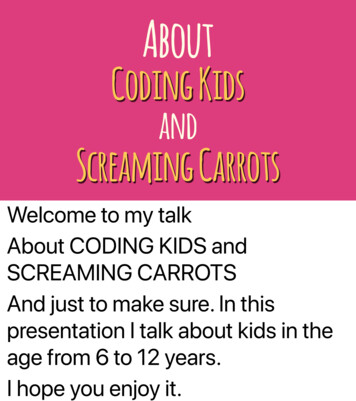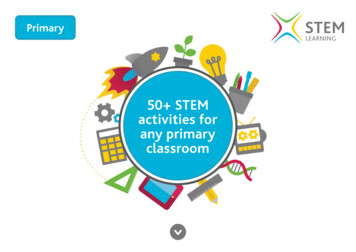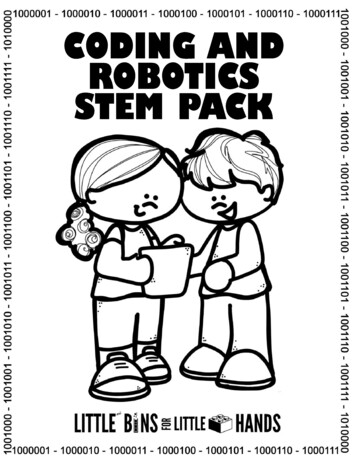
Transcription
CODINGANDROBOTICSSTEMPACK
CODING&ROBOTSALGORITHMCODINGGAME
littlebinsforlittlehands.com
littlebinsforlittlehands.com
littlebinsforlittlehands.com
littlebinsforlittlehands.com
littlebinsforlittlehands.com
littlebinsforlittlehands.com
littlebinsforlittlehands.com
littlebinsforlittlehands.com
littlebinsforlittlehands.com
littlebinsforlittlehands.com
littlebinsforlittlehands.com
littlebinsforlittlehands.com
littlebinsforlittlehands.com
littlebinsforlittlehands.com
littlebinsforlittlehands.com
littlebinsforlittlehands.com
Help Put theRobot TogetherAlgorithmActivity
Help Put the Robot Together Algorithm ActivityThis activity invites children to complete an algorithm that will put a robot together. Beforeyour children create an algorithm that connects each of the parts of the robot in order, youwill want share a simple definition for an algorithm with them and read them the Putting theRobot Together story below.What is an algorithm?An algorithm is the series of steps a computer follows to complete a task. Your children mayneed real life example of an algorithm. A simple algorithm they do every day is washingtheir hands.Here is a version of handwashing you could share:1.2.3.4.5.6.Turn on the water.Wet your hands.Place soap on your hands.Rinse the soap off your hands.Turn off the water.Dry your hands.Getting Started1. You will need to print out an algorithm sheet for each child.2. Then you can share the robot story.3. Next your children will connect the robot’s sections together with arrows on theiralgorithm sheet. They will need to have the arrows putting the direction Daniel andClaire would need to go to get from one robot section to the next until the robot hasbeen assembled.Example: They will draw an up arrow in the box that says start and contains the body.Then they will draw an up arrow in the box between the body and the head. They will draw an up arrow in the box with the head. They will need to draw an arrow pointing to the right in the box above the head. They will then continue to connect the robot parts together in the same orderthey are mentioned in the instructional manual.littlebinsforlittlehands.com
Putting the Robot Together StoryDaniel and Claire hated to clean their rooms. Yet every Saturday morning they knew theirparents expected them to clean them right after breakfast. All their toys needed to be putaway. Their clothes needed to be put in their hampers and then brought down to thelaundry room. Then they needed to make their beds and vacuum the carpet on the floor oftheir rooms.One Saturday it took until almost lunch time to get their rooms picked up and cleaned. Overlunch Daniel and Claire decided they needed to get some help cleaning. What if they pooledtheir birthday and holiday money from their grandmother to buy a robot. A robot wouldhelp them clean their rooms faster.It took a few searches online to find the LBLH-J4. The LBLH-J4 was a robot designed to helpdo chores around the house. Daniel and Claire decided it would be just the right robot forthem. It came with wheels that would help it roll around their rooms. It had pinchers at theend of its arms that would be great for picking clothes and toys.Before Dad ordered the LBLH-J4 for them, he reminded them that the robot would come inpieces. It would have to be put together before it could help them clean.It took almost two weeks for the box containing their robot to arrive. When it did, itcontained an instruction manual and the robot in seven sections.The manual gave the following steps for putting the robot together:1.2.3.4.5.6.7.8.Put the robot’s body on a flat surface.Screw the robot’s head onto the body.Place the antenna hat on top of the robot’s head.Attach the right arm to the body next to the grid screen.Attach the left arm next to the column of lights on the body.Screw one of the roller legs on the bottom of the body.Screw the second roller leg onto the bottom of the body.When all the parts have been attached, you will have a complete robot.It took at little bit of help from both mom and dad to put the robot together. They finallyfinished assembling it on a Wednesday after school. Daniel and Claire decided they couldn’twait until Saturday to clean their rooms. Their parents agreed that Wednesday would be afine day for them to clean their rooms. Any or every day would be a great day to clean theirrooms their parents told them. As long as they had a robot to help them, Daniel and Clairethought so too.littlebinsforlittlehands.com
STARTENDlittlebinsforlittlehands.com
ENDSTARTlittlebinsforlittlehands.com
ENDSTARTlittlebinsforlittlehands.com
ROBOTCHALLENGESlittlebinsforlittlehands.com
Robot ChallengesThe robot challenge grid activity invites children to create their own unique path for a robotto follow. Each card presents a different set of path building guidelines. Once your childrenhave prepared their grid, they will need to create a path with arrows. The path will takethem from the beginning to the end of each challenge.This challenge gives your children two opportunities to interact with algorithms. Eachchallenge card displays a creation algorithm. The path your child creates with arrows toget from start, around the colored in boxes, and to the end box is the second algorithm.You may want to walk your children through the algorithm challenges. They may not be surewhat the algorithms are asking them to do. Others may know what the symbols mean, butmay not be able to read the words on the challenge card. Still, others may need help withthe words and the symbols.It will be up to you do decide if you want your children to work in a group with you, one-onone with you or on their own. There really isn’t a wrong way to have them complete thechallenges.littlebinsforlittlehands.com
Robot Challenge Gridlittlebinsforlittlehands.com
Place an X in corner boxPlace an X in a center boxPlace an O in corner boxPlace an O in corner boxColor in 5Color in 7on the gridCreate a path with arrowsthe X to the O around thefromon the gridCreate a path with arrowsthe X to the O around thePlace an X in a bottom boxPlace an X in a bottom boxPlace an O in corner boxPlace an O in corner boxColor in 6Color in this patternon the gridCreate a path with arrowsthe X to the O around thefromCreate a path with arrowsthe X to the O around thelittlebinsforlittlehands.comfromfrom
Place an X in aPlace an X in aPlace an O in aPlace an O in aColor in this patternColor in this patternCreate a path with arrowsthe X to the O around thefromCreate a path with arrowsthe X to the O around thePlace an X in aPlace an X in aPlace an O in aPlace an O in corner boxColor in this patternColor in this patternCreate a path with arrowsthe X to the O around thefromCreate a path with arrowsthe X to the O around thelittlebinsforlittlehands.comfromfrom
Writestart in a square on the left handedge of the grid. Write finish in a square on theright hand edge of the grid. Color in six squares to createbarriers. The colored squarescan not touch each other. Create a path that connects thestart square to the finishsquares using arrows that point up, down,left or right. ColorWarning: Your path has to go around the barriers.Warning: Your path has to go around the barriers. Write Writestart in a square in the middle of thegrid. Write finish in a square in asquare on the edge of the grid. Color in seven squares tocreate barriers. The coloredsquares can not touch eachother. Create a path that connects the startsquare to the finish squares using arrowsthat point up, down, left or right.Warning: Your path has to go around the barriers.in squares each corner and thecenter to create barriers. Write start in a square on theleft hand edge of the grid. Write finish in a square on theright hand edge of the grid. Create a path that connectsthe start square to the finishsquares using arrows that point up, down,left or right.start in a square at the top of thegrip Write finish in a square at thebottom of the grid. Color in eight squares to createbarriers. The colored squarescan not touch each other. Create a path that connects thestart square to the finishsquares using arrows that point up, down,left or right.Warning: Your path has to go around the barriers.littlebinsforlittlehands.com
Writestart in one of the corner squares. Write finish in the square in the oppositecorner. Color in four squares thatconnect the corner squaresdiagonally to create wall. Create a path that connects thestart square to the finish squaresusing arrows that point up,down, left or right.Warning: Your path has to go around the barriers. Writestart in one of the corner squares. Write finish in the square in the oppositecorner. Color in four squares in thecenter of the grid. Create a path that connectsthe start square to the finishsquares using arrows thatpoint up, down, left or right.Warning: Your path has to go around the barriers.littlebinsforlittlehands.com
Drawing a Robot Based on an Algorithmlittlebinsforlittlehands.com
Years ago when people learned to code. They needed to learn a computer language like Cobol, Basic orC . The language features a combination of words, letters, numbers and symbols.A few years ago Neil Fraser invented a coding language called Blockly Blocks which features visual blockprogramming. A series of command or function blocks are linked together vertically to create an algorithmor series of steps needed to complete a task.examples:Coding sites for children like Tynker and Code.org feature Blockly Blocks in their coding activities. Beforeyou have them put Blockly blocks together online, you can have them follow an algorithm offline. One waythey can work with a Blockly block algorithm is to follow the steps you need to draw an object like a robot.The algorithm or series of steps needed to draw and color a robot can be found on the Drawing a RobotBased on an Algorithm worksheet.What will they do? Your children will draw what is mentioned or pictured in each of the blocks from the topblock to the bottom block. When they are completed each step displayed in the block, they will have drawna robot.littlebinsforlittlehands.com
Counting to Ten With RobotsWhen you tell your children that they will be creating an algorithm while completing thisactivity. They will probably have no idea what the word algorithm means. Yet they usealgorithms each and every day.An algorithm is a series of steps needed to complete a task. A computer follows analgorithm each time you type something into a computer or touch a computer screen. Itfollows the clicks you perform on a keyboard or the taps you do on your computer’s screen.Then it translates them into the steps that it needs to compete so the computer does whatyou need it to.Every day your children follow the steps they need to get dressed for school, walk down ahallway, or finish an assignment you give them. If they skip any part of one of thoseactivities, the task won’t be completed well. They could forget to tie their shoes, lift up onefoot and then another, or put their name on their paper.As your children complete this activity they will need to connect the numbers from 1 to 10 inorder. They will show what direction you need to go from one box to another with arrows.Example: Your children will draw an up arrow in the box with the number one.They will draw an up arrow in the box between the one and the two.Next, they could draw an up arrow or an arrow pointing to the right in thenumber two box.If they drew an up arrow, they will draw an up arrow in the box above thenumber two box. Then they will draw a right arrow in the left-hand corner box toget the three box.If they drew a right arrow in the number two box, they will draw an up arrow inthe box beside the two and one in the box above that one.Sometimes there is just one direction to go. Other times there is more than one way.Computer programmers sometimes have the same thing happen. There is more than oneway to complete a programming algorithm. Most programmers will try to complete analgorithm with the fewest number of steps. Your children will probably want to do the samething.littlebinsforlittlehands.com
38729416510littlebinsforlittlehands.com
binary codeCoding ornaments are the perfect craft activity for the kid who doesn'tcare too much for crafts! Screen-free coding and ornament making asyou explore the binary code.SUPPLIES 3 Colors of BeadsPipe CleanersPrintable Binary Code SheetChoose one color bead for the number 1 and another color bead forthe number 0. Choose a 3rd color bead to use as a spacer betweenletters.Bend your pipe cleaner into any whimsical shape.Choose a word or your name to be represented with the binary code.Use the printable sheet to write down the code.If your word is too long for one pipe cleaner, simply attach another! Useribbon or another type of fastener to hang in your window or tune intoa keychain!The computer doesn't read the letter A like we read the letter A. Itreads it in a series of 1's and 0's. Each letter has its own code of 1's and0's. This code is called the ASCII Binary Alphabet.The binary number system is a base-2 number system. This means it onlyhas two numbers: 0 and 1. The number system that we normally use isthe decimal number system. It has 10 numbers: 0-9.Computers work best with an “on” and “off” system and that is justwhat the binary code is all about. 1 is “on” and 0 is “off”.littlebinsforlittlehands.com
Alphabet in binary codelittlebinsforlittlehands.com
Write your first name in lebinsforlittlehands.com
Write your last name in lebinsforlittlehands.com
color the ��————littlebinsforlittlehands.com
Alphabet in binary codelittlebinsforlittlehands.com
Solving Riddles With Binary CodeFind the answers to these alphabetriddles using the binary code.What letter gathers nectar for honey?Answer: 01100010 orWhat letter helps you see?Answer: 01101001 orWhat letter is like a ring around your finger?Answer: 01101111 orWhat letter is a hot or cold drink?What letter asks a question?Answer: 01110100 orAnswer: 01111001 orWhat letter is something you stand in?Answer: 01110001 orWhat letter is very deep and full of water?Answer: 01100011 orWhat letter is the favorite of a pirate?Answer: 01110010 orWhat letter is a type of blue bird?Answer: 01101010 orWhat letter is a type of green vegetable?Answer: 01110000 orlittlebinsforlittlehands.com
Solving Riddles With Binary Codeanswers1. B (bee)2. I (eye)3. O4. T (tea)5. Y (why)6. Q (queue)7. C (sea)8. R (arrrr!)9. J (jay)10. P (pea)littlebinsforlittlehands.com
numbers in binary codelittlebinsforlittlehands.com
Help the robots add With Binary CodeHelp the robots figure out what number each binary code equals.Then write the number above the code. Finally write each sum.1. 00110010 00110100 2. 00110110 00110011 3. 00110000 00110001 4. 00110101 00110000 5. 00110101 00110100 littlebinsforlittlehands.com
Help the robots add With Binary CodeHelp the robots figure out what number each binary code equals.Then write the number above the code. Finally write each sum.6. 00110110 00110010 7. 00111000 00110001 8. 00110101 00110010 9. 00110111 00110001 10. 00111001 00110000 littlebinsforlittlehands.com
Help the robots add With Binary CodeHelp the robots figure out what number each binary code equals.Then write the number above the code. Finally write each sum.11. 00110001 00110111 12. 00110001 00110100 13. 00110110 00110001 14. 00110011 00110101 15. 00110010 00110010 littlebinsforlittlehands.com
Help the robots add With Binary CodeCreate your own addition problems to solve. littlebinsforlittlehands.com
answers1. 00110010 001101002 4 6 (00110110)9. 00110111 001100017 1 8 (00111000)2. 00110110 001100116 3 9 (00111001)10. 00111001 001100009 0 9 (00111001)3. 00110000 001100010 1 1 (00110001)11. 00110001 001101111 7 8 (00111000)4. 00110101 001100005 0 5 (00110101)12. 00110001 001101001 4 5 (00110101)5. 00110101 001101005 4 9 (00111001)13. 00110110 001100016 1 7 (00110111)6. 00110110 001100106 2 8 (00111000)14. 00110011 001101013 5 8 (00111000)7. 00111000 001100018 1 9 (00111001)15. 00110010 001100102 2 4 (00110100)8. 00110101 001100105 2 7 (00110111)littlebinsforlittlehands.com
InspirationalCode BreakerPuzzleslittlebinsforlittlehands.com
Robot Word lehands.com
"."- Albert EinsteinWhat does this quote mean to you?littlebinsforlittlehands.com
."- Thomas EdisonWhat does this quote mean to you?littlebinsforlittlehands.com
",!"- YodaWhat does this quote mean to you?littlebinsforlittlehands.com
"."- Maya AngelouWhat does this quote mean to you?littlebinsforlittlehands.com
"."-John WoodenWhat does this quote mean to you?littlebinsforlittlehands.com
"?"- Dr. SeussWhat does this quote mean to you?littlebinsforlittlehands.com
"Apernevermistatriedne w."skonmaeanwhodeneverythin- Albert Einsteinlittlebinsforlittlehands.comag
"Toineedimagandjun k."nvent,goodationpileaian- Thomas Edisonlittlebinsforlittlehands.comyouof
"Dothetry!"ordonoreisno- Yodalittlebinsforlittlehands.comt,
"W henybetterbetter."ouykounowdo- Maya Angeloulittlebinsforlittlehands.com
"M akdaymaseteacyourerpihec e."-John Woodenlittlebinsforlittlehands.com
"W hywheborout?"fitnyontoius- Dr. Seusslittlebinsforlittlehands.comnweretand
graphics creditfor this pack
Years ago when people learned to code. They needed to learn a computer language like Cobol, Basic or C . The language features a combination of words, letters, numbers and symbols. A few years ago Neil Fraser invented a coding language calle
